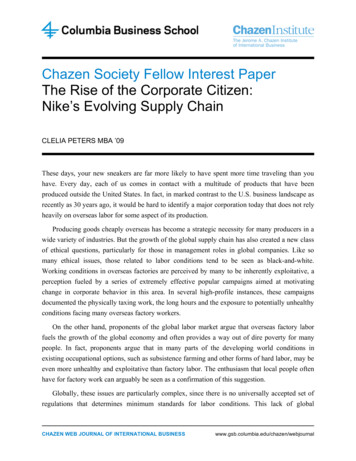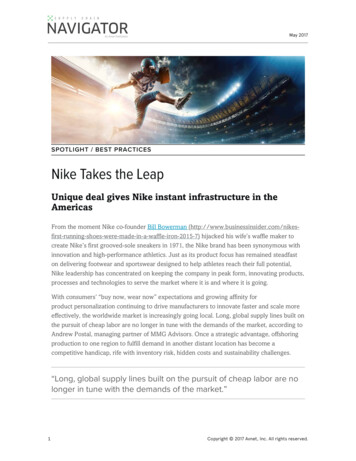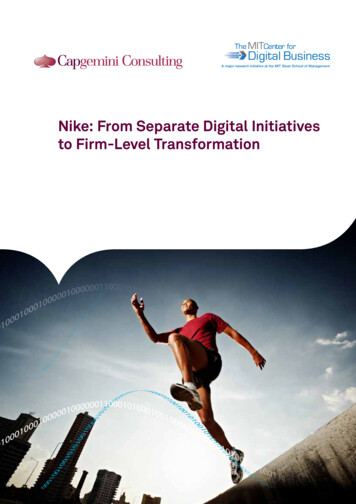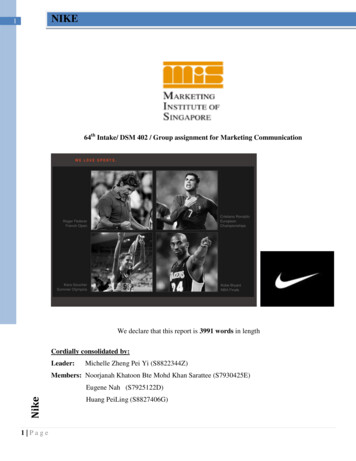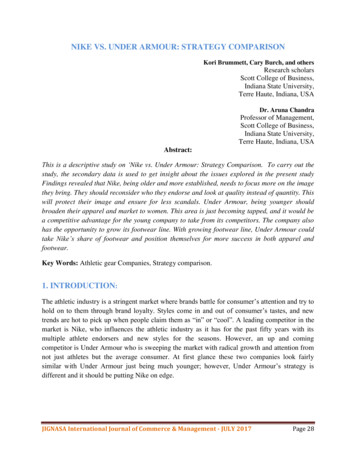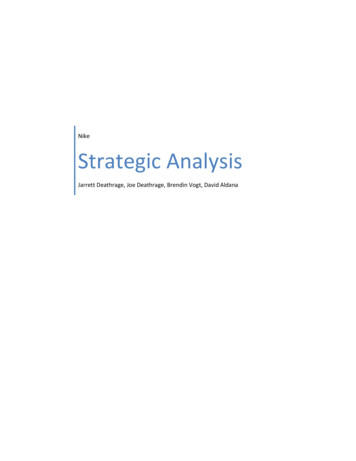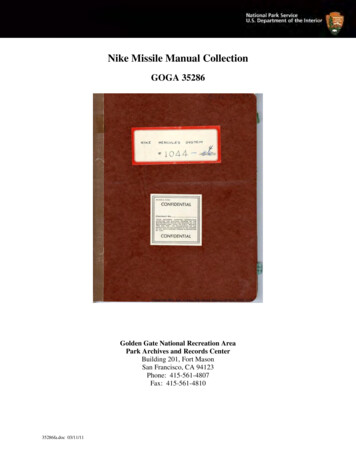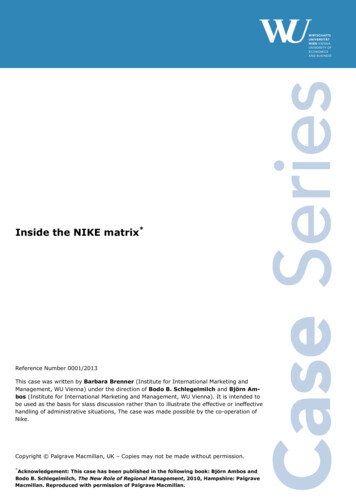
Transcription
Inside the NIKE matrix*Reference Number 0001/2013This case was written by Barbara Brenner (Institute for International Marketing andManagement, WU Vienna) under the direction of Bodo B. Schlegelmilch and Björn Ambos (Institute for International Marketing and Management, WU Vienna). It is intended tobe used as the basis for slass discussion rather than to illustrate the effective or ineffectivehandling of administrative situations, The case was made possible by the co-operation ofNike.Copyright Palgrave Macmillan, UK – Copies may not be made without permission.*Acknowledgement: This case has been published in the following book: Björn Ambos andBodo B. Schlegelmilch, The New Role of Regional Management, 2010, Hampshire: PalgraveMacmillan. Reproduced with permission of Palgrave Macmillan.
“To bring inspiration and innovation to every athlete in the world, if you have a body, youare an athlete”. Nike’s mission statementIntroduction“We are on the offense, always”, is boldly printed on the front page of Nike’s Annual Report 2008i. According to Phil Knight, Nike’s founder, “Business is war without bullets”. Andindeed, Nike is very much a growth company with an ever expanding portfolio and a tremendous brand value. And it’s been doing well, hence, Mark Parker, CEO and president ofNike, proudly commented on the company’s 2008 performance: “I’m very pleased withhow we have enhanced the position, performance, and potential of all the brands and categories in the NIKE, Inc. family.”iiGrowth, however, creates structural challenges. This is all the more true for global playerssuch as Nike Inc. who need to juggle tradeoffs of local responsiveness and global integration on a daily basis. Hence, this case takes a look behind the scenes and focuses on howNike manages and structures its worldwide operations. In particular, aspects of regionalmanagement and the splitting of functions and responsibilities between global headquarters and regional headquarters in Europe are highlighted.Key Facts & FiguresHeadquartered in Beaverton, Oregon, Nike Inc. is the largest seller of athletic footwearand athletic apparel in the world and is traded on the New York Stock Exchange.iii For thefiscal year ending May 31st 2008, Nike reported record revenues of USD 18.6 billion, aUSD 2.3 billion increase over last year’s earnings, that’s up 14 percent with growth in every region and every business unitiv. Gross margins improved by more than a percentagepoint to a record high of 45 per cent, and earnings per share grew by 28 per cent.Nike operates on six continents, employs over 30,000 people worldwide and has a workforce of over 800,000 workers in contract factories.v The leading designer, marketer anddistributor of athletic footwear, apparel, equipment, and accessories is represented by 14Niketowns, over 200 Nike Factory Stores, 12 Nike Women stores and over 100 sales andadministrative offices around the world. Nike products are distributed under the Nikebrand and Nike Inc. affiliate brands such as Bragano, Bauer Nike Hockey, Cole Haan, gSeries, Hurley, Converse, Chuck Taylor, All Star, One Star, Jack Purcell, Starter, TeamStarter, Asphalt, Shaq and Dunkman.viIn 2008, the footwear segment generated revenues of USD 9,732 million, apparel salesamounted to USD 5,234 and equipment sales reached USD 1,069 million in all three majorregions. Total pre-tax income increased by 14 per cent to USD 2, 509, 9 million in fiscal2008.The Nike brand includes footwear, apparel and equipment in six core categories: running,basketball, football (soccer), women’s fitness, golf, and tennis, men’s training and sportculture.vii Nike products are sold through Nike owned stores and independent distributorsin over 160 countriesviii. Footwear and Apparel production is outsourced to independentmanufacturers outside the U.S. while equipment is produced both in and outside the U.Six.1
Nike works with 137 contract factories in the Americas, 104 in EMEA, 252 in North Asia,and 238 in South Asiax.History snapshotBill Bowerman and Phil Knight founded the company “Blue Ribbon Sports” in 1964. Bothcontributed USD 500 to the partnership and managed to sell 300 pairs of Tiger runningshoes within three weeks. Some eight years later, they introduced a novel brand of athletic footwear called “Nike”, named after the Greek goddess of victory.Eight years later, they introduced a new brand of athletic footwear called Nike, named after the Greek goddess of victory. In 1972, Blue Ribbon Sports launched the Nike line offootwear. In 1980 the company went public and within the following year Nike became thepredominant brand of the company. In 1986, corporate revenues surpassed USD 1 billionfor the first time. With the “Swoosh” trademark logo and its slogan “Just do it” Nike crafted a unique brand image in the 1980sxi. Nike underwent a period of substantial expansionin the 1990 starting with the acquisition of Cole Haan, an American luxury brand, followedby other major strategic acquisitions such as the ice hockey equipment brand Bauer(1994) and Converse (2003). xiiKey regionsA geographical breakdown of Nike’s revenues shows that the majority of revenues aremade outside the U.S. market. In fiscal 2008, non-U.S. sales (including non-U.S. sales ofCole Haan, Converse, Exeter Brands Group, Hurley, NIKE Bauer Hockey, Umbro, and NIKEGolf) accounted for 57 per cent of total revenues, compared to 53 per cent in fiscal 2007.In 2008, with USD 6,378 million accounting for 40 per cent of Nike’s total sales, the U.S.was Nike’s single most important market. USD 5,620.4 million or 35 per cent of its globalrevenues were achieved in the EMEA region. The Asia-Pacific region recorded sales of USD2,881.7 million or 18 per cent of Nike’s global sales (Nike Annual Report 2008). Lastly,with USD 1,154.1 million the Americas region made the smallest share. Thus, togetherwith other smaller markets, Nike’s global sales were approximately USD 18 billion in fiscal2008, up by 14 per cent compared to the previous year.2
Figure 1: Breakdown of revenues per region 2008.7%18%40%USEMEAAsiaAmericas35%Source: Nike Annual Report 2008Nike sells athletic footwear and apparel in over 160 countries worldwide via Nike-ownedretail stores, independent distributors and licensees. The Nike brand accounts for morethan 90 per cent of Nike’s total revenuesxiii. In 2006, USD 13 billion out of USD 14.9 billionwas generated by the Nike brand (Nike 2006a: 27). Nike’s most significant worldwide customer is the retail chain Footlocker which accounted for around 10 per cent of Nike’s global brand sales in fiscal 2006.United StatesAll roads at Nike lead to Beaverton (Oregon), where Nike’s world HQ is located. Distribution facilities and customer service centers are based in Memphis (Tennessee) and Wilsonville (Oregon) and all over the U.S. Nike’s U.S.-based subsidiaries include Cole Haan Holdings Inc. (Maine), Bauer Nike Hockey Inc. (New Hampshire), Hurley International LLC(California), Nike IHM Inc. (Oregon), Converse Inc. (Massachusetts) and Exeter BrandsGroup LLC (New York).xivTable 1: US Retail stores in 2008U.S. Retail StoresNumberNike Factory Stores121Nike Stores (incl. Nike Women Stores)14Niketowns12Nike Employee-Only Stores3Cole Haan Stores (factory stores etc.)102Converse Stores (factory stores etc.)35Hurley Stores9Total296Source: Nike Annual Report 2008:43
In addition to Nike’s principal properties, the company leases other properties outside theU.S., including 22 production offices, 93 sales offices and showrooms, 76 administrativeoffices and 418 retail stores and factory outlet storesxv. Moreover, the company runs some296 retail stores in international markets (see Table 2).Table 2: Non-U.S. Retail StoresNon-U.S. Retail StoresNumberNike Factory Stores141Nike Stores & Employee-Only Stores46Niketowns3Nike employee-only stores12Cole Haan Stores (Factory Storesetc.)Hurley Stores57Total2601Source: Nike Annual Report 2008:4Nike’s U.S. home base represents the company’s most important single market (see appendix). However, with only 4 per cent growth from 2007 to 2008, this region was outperformed by other regions with distinctively higher growth rates, such as the EMEA region(19 per cent growth) or Asia-Pacific (26 per cent growth). Nevertheless, with USD 6,378million representing 40 per cent of Nike’s total sales, the U.S. remained Nike’s single mostimportant marketxvi. With a 20 per cent market share in the athletic shoe market, Nike iscurrently the dominant leader in this segment in the U.S.xvii Nike’s major competitors inthe U.S. footwear market include Adidas Reebok, Brown Shoe, the Jones Apparel Group,Timberland and Wolverine World Wide. Footwear revenues increased by 6 per cent in2008, compared to 2007 up to USD 4,326.8 million, apparel revenues grew by 2 per centto USD 1,745.1 million; and equipment revenues fell by 5 per cent to USD 306.1 millionxviii.EMEANike first started selling their products in Europe in 1978 and established its first Europeanheadquarters two years later.xix Prior to setting up their European headquarters for theEMEA region in the Netherlands in 1999, Nike coordinated its European activities from theUK and Germany company (Nike 2006a: 17). Mainly financial, tax and other economic incentives paired with excellent language skills and the favourable central location found inHilversumxx induced Nike to relocate their regional headquarters from Frankfurt to theNetherlands.xxi Figure 2 provides an overview over the 27 countries within the EMEA region.4
Figure 2: EMEA RegionSource: http://www.nike.com/nikebiz/nikebiz.jhtml?page 32.The following countries are included in the EMEA region: Austria, Belgium, Bulgaria, Croatia, Czech Republic, Denmark, Finland, France, Germany, Greece, Hungary, Ireland, Israel, Italy, Lebanon, the Netherlands, Norway, Poland, Portugal, the Russian Federation,Slovakia, Slovenia, South Africa, Spain, Sweden, Switzerland, Turkey and the UnitedKingdom. As a result of restructuring processes, Israel, the Middle East is also part of theEMEA region. Similarly, also Africa reports to the regional headquarters in Hilversum since2000.xxiiAlthough EMEA represents Nike’s largest region in terms of territory it is only Nike’s second largest region in terms of revenues.xxiii In fiscal 2008, EMEA accounted for 35 percent of Nike’s global sales or USD 5.620,4 million which is an increase of 19 per cent compared to the previous year. Overall growth in the region was driven by the emerging markets including Russia, Turkey and South Africa. Nike and Adidas-Reebok are the leadingcompanies in the athletic footwear sector in the European footwear market. In 2008,some 55 per cent of Nike’s European sales were in the footwear segment, with runningbeing the most dominant category, followed by soccer. The category running shoes accounts for 30 percent of total sales of athletic footwear in Europe. In the running segmentNike faces strong competition by Asics and New Balance while Adidas-Reebok and Umbroare major rivals in the soccer segmentxxiv.5
Asia-PacificThe Asia Pacific region is Nike’s number one region in terms of manufacturing and represents Nike’s third largest region in terms of revenues.xxv Currently, the Asia-Pacific regioncomprises Australia, China, Hong Kong, India, Indonesia, Japan, Korea, New Zealand,Singapore, Malaysia, Philippines, Thailand, Sri Lanka, Taiwan and Vietnam.The AmericasCanada, Mexico and South America make the Americas region. Nike has subsidiaries infive countries within the region: Argentina, Brazil, Chile, Mexico and Canada.xxvi The Americas region is Nike’s smallest region in terms of sales.Inside the Nike matrixNike Inc. comprises 44 wholly-owned subsidiaries of which seven are U.S.-based. All subsidiaries, except for Nike IHM Inc., Triax Insurance Inc., and Nike (Suzhou) Sports Company Ltd., deal with the design, marketing, distribution and sale of athletic and leisurefootwear, apparel, accessories, and equipmentxxvii. The U.S. based Nike IHM Inc. manufactures plastics and Air-Sole shoe cushioning components, the Hawaii based corporation Triax Insurance Inc. is an insurance company, and the Chinese based Nike (Suzhou) SportsCompany Ltd. manufactures footwear and Air-Sole shoe cushioning components. Nike’sU.S. subsidiaries comprise Nike Golf, Cole Haan Holdings Inc., Bauer Nike Hockey Inc.,Hurley International LC, Converse Inc. and Exeter Brands Group LLCxxviii.Figure 3: Subsidiaries of Nike roupSource: http://www.nike.com/nikebiz/nikebiz.jhtml?page 3&item facts#emeaNike has a five-year strategy to ensure global growth and sustain or build market leadership of the Nike brand and affiliated brands for the period 2006 to 2011. Top-line revenueis planned to grow from USD 15 billion to USD 23 billion by 2011.xxix Ongoing product innovation, brand leadership and retail experience as well as further regional expansion willbe part of the strategy. Geographically spoken, Nike expects further growth in its U.S.home turf, the U.K., Japan and China but also in Russia, India and Brazil.6
Nike is organized by a matrix structure, which entails multiple responsibilities and reporting lines for each unit which might be problematicxxx. However, Nike’s performance figures(see appendix) seem to tell a different story. Nike executives point to the importance ofleadership in a matrix structure:The other sort of interesting thing is, there is always a lot of discussion on organizational structure within Nike and when you first enter this company, youjust wonder how it can actually work, this matrix structure. Seems likethere is no clear line accountability, it must be very hard to get a decision madehere. that’s kind of your initial reaction when you are coming form the outsideand you hear people describe how it works. But then after you are here for a whileyou notice that here leaders are able to get decisions made very quicklyand are able to
The Nike brand includes footwear, apparel and equipment in six core categories: running, basketball, football (soccer), women’s fitness, golf, and tennis, men’s training and sport culture.vii Nike products are sold through Nike owned stores and independent distributors in over 160 countries viii. Footwear and Apparel production is outsourced to independent

